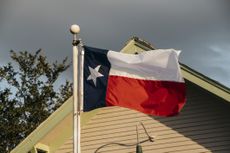Kiplinger's GDP Outlook: Economic Growth Is Slowing to Normal
The economy’s quarterly growth rate will likely average 2.0% from now on.

Kiplinger’s Economic Outlooks are written by the staff of our weekly Kiplinger Letter and are unavailable elsewhere. Click here for a free issue of The Kiplinger Letter or to subscribe for the latest trends and forecasts from our highly experienced Kiplinger Letter team.
After a strong fourth-quarter GDP growth rate of 3.2%, quarterly growth is likely to slow to an average of 2.0% this year, which is roughly in line with the economy’s potential growth rate. The strong consumer spending that has propelled higher-than-average quarterly growth over the past year will likely come to an end this year. Consumer spending, in turn, likely depends on inflation-adjusted disposable income growth, which will be around 1.7%, much below the 4.2% growth last year. A contributor to the spending slowdown is slowing wage growth, which should return to a more normal level of 3.5%.
Other spending will also grow more moderately. Business spending will likely stay at the current modest rate because of high interest rates and tight bank lending standards, which will also continue to hobble the housing market. Federal outlays will gradually ebb, as previous spending programs funded by Congress run their course. State and local governments have been hiring because they are still catching up after the pandemic, but they will start to cut back as their staffing levels approach normal. Exports and imports will likely revert to being a net drag on growth instead of a contributor.

Sign up for Kiplinger’s Free E-Newsletters
Profit and prosper with the best of expert advice on investing, taxes, retirement, personal finance and more - straight to your e-mail.
Profit and prosper with the best of expert advice - straight to your e-mail.
The Federal Reserve will likely begin cutting interest rates this year, which will help boost consumer spending on housing and motor vehicles, and will help spur growth in business loans. Also, business sentiment ought to improve as a result of the Fed’s rate-cutting signal, encouraging more business managers to start purchasing equipment and making plans for expansion.
Average GDP growth for 2024 will be 2.5%, the same as 2023’s 2.5% growth, but will slow down to 1.9% in 2025. The strong growth at the end of 2023 will boost 2024, too, because even slower quarterly growth in 2024 would be from a higher starting point. But this will no longer be true beginning in 2025.
The reason we consider 2.0% growth to be “normal” is that the economy can typically expand its productive capacity by that amount in any given year. The labor force typically grows at around 0.5%. Improvements in labor productivity will usually average out to 1.5%, so the two together add up to 2.0%. If labor productivity rises faster than 1.5%, then the economy’s speed limit without causing inflation to spike would be higher. Some economists have speculated that the artificial intelligence revolution could raise average productivity, but those benefits will likely take some time to be realized.
Source: Department of Commerce: GDP Data
Read more

To continue reading this article
please register for free
This is different from signing in to your print subscription
Why am I seeing this? Find out more here

David is both staff economist and reporter for The Kiplinger Letter, overseeing Kiplinger forecasts for the U.S. and world economies. Previously, he was senior principal economist in the Center for Forecasting and Modeling at IHS/GlobalInsight, and an economist in the Chief Economist's Office of the U.S. Department of Commerce. David has co-written weekly reports on economic conditions since 1992, and has forecasted GDP and its components since 1995, beating the Blue Chip Indicators forecasts two-thirds of the time. David is a Certified Business Economist as recognized by the National Association for Business Economics. He has two master's degrees and is ABD in economics from the University of North Carolina at Chapel Hill.
-
 Is a Phased Retirement Right for You?
Is a Phased Retirement Right for You?Want to keep working, just not as hard? A phased retirement may just be the answer.
By Kimberly Lankford Published
-
 Four Tips to Make Your Sales Presentation a Winner
Four Tips to Make Your Sales Presentation a WinnerBeing prepared and not being boring can go a long way toward persuading a potential customer to buy into what you’re offering.
By H. Dennis Beaver, Esq. Published
-
 A Spotlight on the Pacific States: The Kiplinger Letter
A Spotlight on the Pacific States: The Kiplinger LetterThe Kiplinger Letter Most Pacific states are seeing good job growth in multiple sectors including tourism, hospitality, and construction.
By David Payne Published
-
 The Robots Are Coming... But Not For a While
The Robots Are Coming... But Not For a WhileThe Kiplinger Letter There’s excitement in the tech sector over the potential of humanoid robots, but widespread adoption is likely to be years away.
By John Miley Published
-
 Farmers Face Another Tough Year As Costs Continue to Climb: The Kiplinger Letter
Farmers Face Another Tough Year As Costs Continue to Climb: The Kiplinger LetterThe Kiplinger Letter Farm income is expected to decline for a second year, while costs continue to up-end farm profitability.
By Matthew Housiaux Published
-
 A Spotlight on the Mountain States: The Kiplinger Letter
A Spotlight on the Mountain States: The Kiplinger LetterThe Kiplinger Letter Most Mountain states are seeing good job growth in multiple sectors from healthcare, energy, and semiconductor production to farming and government.
By David Payne Last updated
-
 A Spotlight on the Plains States: The Kiplinger Letter
A Spotlight on the Plains States: The Kiplinger LetterThe Kiplinger Letter The labor market is tight in the Plains states and outside of healthcare and construction most sectors are flat or down.
By David Payne Published
-
 Kiplinger's Commodities Forecast
Kiplinger's Commodities ForecastThe Kiplinger Letter Following a rocky few years for markets, we expect commodities to be less volatile in 2024, as a post-pandemic normal finally emerges.
By Matthew Housiaux Published
-
 Growth Stalls in China As Property Market Continues to Struggle: The Kiplinger Letter
Growth Stalls in China As Property Market Continues to Struggle: The Kiplinger LetterThe Kiplinger Letter The property market remains a major drag on Chinese growth, with sales now 50% below their peak.
By Rodrigo Sermeño Published
-
 A Spotlight on the South Central States: The Kiplinger Letter
A Spotlight on the South Central States: The Kiplinger LetterThe Kiplinger Letter Outside of the tech sector slump, job growth in the South Central states remains buoyant, with healthcare, construction and business investment going strong.
By David Payne Published